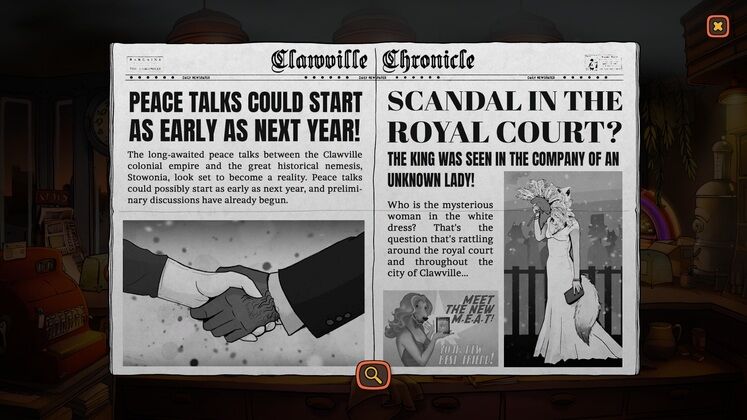Zipp's Cafe Review
A Rather Flat Latte
Zipp’s Cafe is a short game crafted to fulfill two roles. Firstly, it sets the stage for The Wild Gentlemen’s forthcoming title in the Chicken Police series. Secondly, it offers players a succinct yet immersive introduction to the World of Wilderness, the vibrant setting that unites both games.
In the game, you step into the shoes of Zipp, a reformed raccoon who left behind his dubious history to embrace the tranquility of running his own cafe. Situated in a region often referred to as no man’s land, his establishment becomes a haven for an eclectic mix of individuals seeking warm drinks, delicious food, and a sympathetic listener.
Day by day, you assume your position behind the counter, interacting with patrons in the classic style of point-and-click adventure games. Gameplay in Zipp’s Cafe predominantly oscillates between engaging in text-based dialogues, advanced with a simple click of the left mouse button, and crafting an assortment of drinks and meals for your guests.
As the day winds down and it’s time to shut the cafe doors, you’re presented with a final minigame of washing dishes. However, this activity feels mechanically indistinguishable from the previous tasks, lacking a unique touch. While this straightforward gameplay loop aligns with the game’s intent to be a snug, story-focused cafe management simulator, it falls short in evolving into a truly engaging experience.
As customers enter your establishment, you immediately engage in conversation with them. Partway through the interaction, you’re tasked with preparing a specific drink or meal for them. Once served, the dialogue continues briefly before you transition to attending the next patron.
The game’s dialogues strive to impart a natural feel to the exchanges, yet the structured, repetitive nature of the gameplay undermines the sense of immersion. The monotonous process of making drinks and meals is reduced to mere button-clicking and object-dragging. This, compounded by a set of vague tutorial directions, can lead to an early sense of frustration.
While I quickly overcame the initial learning curve, the minigame lost its novelty and became less engaging after the first of three days.
Even with a variety of recipes demanding diverse containers and ingredient measurements for proper preparation, the process inevitably becomes repetitive, as it requires performing the same actions repeatedly.
The routine begins with consulting the recipe, followed by arranging the necessary cookware—be it pans, mugs, or glasses. For coffee, the procedure is constant: start by prepping water and grinding the beans, then load them into the coffee machine and choose from one of the three available beverage options.
Preparing meals involves adding fat or oil to pans and placing them on the stove, followed by the addition of ingredients such as bread, meat, or vegetables. The cooking process is then simply a matter of waiting for a few seconds as you watch a progress circle fill up, indicating when the food is done.
To finish, you enhance the flavor with unlimited supplies of ingredients such as sugar, cinnamon, garlic, or catnip. These must be selected and dragged from their place on the screen, then held over the prepared drinks or meals for a duration sufficient to meet the recipe’s demands before serving them to your customers.
Every customer arrives with distinct tastes, which are plainly indicated. While these preferences tend to align with their personalities or current life events, from a gameplay perspective, they merely introduce an additional minor task to the overall workload.
The act of preparing food and coffee is naturally repetitive; however, Zipp’s Cafe’s oversimplified approach turns what could be a soothing gameplay aspect into a monotonous experience prematurely. This is especially notable for a game that can be completed within a relatively short span of two to four hours.
The game allows for the possibility of botching recipes, but even when it’s not due to the occasional mislabeled tooltip, the consequences of receiving fewer than 5 stars appear negligible. Characters may briefly comment on the less-than-perfect quality of your coffee or dishes before briskly transitioning to the next segment of story-driven dialogue—a shift that can feel abrupt or jarring at times.
The minigames offer a simplified option through a story mode, which allows for a greater focus on the characters’ narratives. In hindsight, part of me wishes I had opted for this route during my playthrough.
Voice acting in Zipp’s Cafe is sparse, confined to the introduction and conclusion sequences, as well as occasional lines at the start of cooking or drink preparation. Yet, the voice work present complements the game’s noir setting, adding depth and personality to its protagonist.
Conversely, the repetitive nature of the jazzy background music begins to wear thin after the third loop, failing to sustain the intended ambiance. Not even the game’s noir filter, which desaturates the screen’s colors with a single click, can compensate for the lack of atmospheric depth that the audio fails to provide.
Zipp’s Cafe partially offsets its shortcomings with engaging conversations held between the protagonist and the five distinct characters who visit the coffee shop. While these interactions often rely on typical genre conventions and seldom offer shock value—aside from one notable twist—they effectively offer insight into the diverse histories, aspirations, and concerns of its cast.
Throughout the narrative of Zipp’s Cafe, there’s a recurring theme of beginning anew or, at the very least, questioning the established norms. While the dialogues tend to be dry, they occasionally let slip meaningful snippets. These exchanges also gradually peel back the layers of the broader world that lies beyond the confines of the cafe, where the entirety of the game unfolds.
Zipp’s Cafe ventures into weighty subject matter, delving into issues like species-based segregation, crime, and personal setbacks. Yet, due to the game’s concise format, these complex themes are only briefly explored, preventing the characters’ struggles from making a truly enduring impact.
The game’s most notable achievement may be the codex entries, which become accessible as you progress. These entries enrich the world by offering a fuller depiction of the game’s universe. While there is a pivotal decision point towards the game’s conclusion that influences the final cinematic, the incentive to replay the entire game for the sake of a different ending may not be compelling enough for all players.
ZIPP'S CAFE VERDICT
The repetitive minigames that occupy a significant portion of the gameplay in Zipp’s Cafe tend to hinder its charm, despite the narrative potential that flickers through its admittedly dry dialogues. While the game succeeds to some extent in immersing players into its expansive setting, the lackluster routine of food and drink preparation, coupled with insufficiently developed characters, makes it challenging to feel drawn into becoming a frequent visitor.
TOP GAME MOMENT
Accessing all the codex entries provides a deeper dive into the broader setting of the game.
Good vs Bad
- Successfully crafts a compelling portrayal of the game's wider universe
- The minigames become tedious over time
- Character development is constrained by insufficient time for their stories to develop fully
- The repetitive background music can be grating










